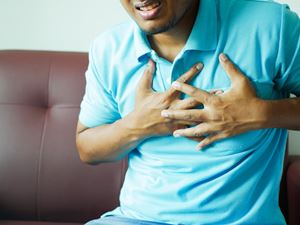
It’s well known that issues like diabetes, smoking, high blood pressure, and not enough exercise are risk factors for a heart attack, but many people might not know the telltale symptoms to tell if a cardiac event is on its way. Experts say there are specific symptoms that happen in the weeks and days before a heart attack that can be a red flag.
Knowing these signs could be a lifesaver. Heart disease is the number one killer of women and men in the United States. According to Dr. Abha Khandelwal, a clinical associate professor of cardiovascular medicine at Stanford, doctors are seeing an increase in death from heart disease, which highlights the importance of being armed with knowledge about the signs and risks. Here are some early warning signs of a heart attack and what to do if you experience them.
Chest pressure of pain.
Dr. Roger Blumenthal says that angina, an irregular chest pain caused by the slow building of plaque inside the arteries, can be a sign that a cardiac event or heart attack may occur in the coming days. A spasm or constriction of the arteries on the outside of the heart can also lead to this warning sign. If you feel any sort of chest discomfort because angina can show up in forms other than pain, it’s essential to call your doctor.
Shoulder, neck or jaw pain.
Typically, heart attacks are associated with immediate pain in the left arm. However, early pain signs might not be as obvious. Sometimes, angina is synonymous with chest pressure or pain, but sometimes, especially with older adults, there may be other symptoms, like pain that radiates through the neck, arm or shoulder. It can also feel like a numbness that goes up into the jaw.
Getting uncomfortable or winded after exertion.
According to Dr. Khandelwal, becoming quickly out of breath can also be a red flag. This may include feeling more winded than usual after doing a simple task, like getting your garden prepared or installing a new light fixture. She added that some people notice chest discomfort or numbness in the arm after extreme exertion as well.
Nausea or other stomach issues.
Nausea, abdominal pain, and overall fatigue are also potential heart attack warning signs, according to Dr. Nikhil Sikand, a Yale Medicine cardiologist. However, he noted that doesn’t go for everyone, adding that some patients may have no or mild symptoms
Symptoms can happen days before a heart attack.
The time between symptoms and a heart attack varies and can look very different from person to person. Dr. Khandelwal said close to two-thirds of her patients review the month before a cardiac event and point to a time when they experienced chest pain. Some may notice worsening symptoms in the days leading up to the heart attack. She added that often, the day of or the week leading up to a heart attack can be filled with symptoms.
These symptoms can last longer, be more frequent, or might be more severe. If you notice any symptoms, getting help is imperative, especially if the issues come on severely and quickly. In that case, Dr. Khandelwal said you should call 911 immediately. If you have no history of heart disease and notice minor symptoms, you should still tell your doctor. They can help you decide what to do and arrange any necessary testing. Those who get quick medical attention, even after a heart attack, can get lifesaving treatment.
Preventing heart attacks in your everyday life.
Many risk factors are out of your control, but some are in your hands. Simple behaviors like cutting out certain foods or committing to a daily walk can help reduce your chances of a heart attack, along with knowing your numbers, like blood sugar, cholesterol, and blood pressure, and being aware of the warning signs of a heart attack.
Before you have the disease and start getting older, if you can work daily on controlling risk factors, that’s the most powerful thing a person can do, according to Dr. Khandelwal. Even if you have heart disease, it’s essential to know the factors and do what you can to keep yourself healthy. Once someone suffers from a heart attack, they’re much more likely to have another heart attack in the subsequent year. It’s vital to modify your risk factors, which are lifestyle habits and get the appropriate medical attention.
The American Heart Association says that the traditional heart attack risk factors are high cholesterol, smoking, diabetes, obesity, and high blood pressure. CardioSmart, an American College of Cardiology resource, is an excellent tool for those looking to learn how to lessen their heart attack risk. Using this tool can help you find ways to learn about exercise benefits on your heart, help you quit smoking, get healthy eating tips and more. Beyond at-home mitigation strategies, it may also help to keep in touch with your doctor.
Outside of regular exercise and a healthy diet, the most important thing anyone can do is follow closely with a health professional regularly to treat and identify potential risk factors for heart disease.

